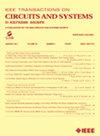A 28-nm MFCC-Free Keyword Switchable Keyword Spotting (KWS) System With Transferred Training Algorithm
IF 4.9
2区 工程技术
Q2 ENGINEERING, ELECTRICAL & ELECTRONIC
IEEE Transactions on Circuits and Systems II: Express Briefs
Pub Date : 2025-03-19
DOI:10.1109/TCSII.2025.3552970
引用次数: 0
Abstract
In this brief, we propose an ultra-low-power mel frequency cepstral coefficients (MFCCs)-free keyword switchable KWS system that supports ten sub-classifiers (2 keywords each, 20 keywords in total) through a time-domain transferred training convolutional neural network (TT-CNN). The proposed TT-CNN reduces the model size by sharing the first two convolutional layers with all the keywords with a transferred training approach. Hence, the power budget for memory and computation is largely reduced. The TT-CNN supports flexible keyword demand in different scenes by selecting different kernels in the custom-designed 5T-SRAM. The time-domain feature of the proposed TT-CNN avoids the power-hungry feature extractor (FEx), further reducing the overall power consumption. To benchmark with the state-of-the-art, we demonstrated the proposed system with two cascaded scalable 10-Class KWS chips in 28nm CMOS. Our design achieves a high accuracy of 92.8% on 20 keywords from the Google speech command dataset (GSCD). It also shows that the memory overhead for each keyword can be reduced by 20% with the lowest reported 20-class KWS power consumption of具有转移训练算法的28纳米无mfcc关键字可切换关键字定位系统
在本文中,我们提出了一个超低功耗的无频率倒谱系数(MFCCs)关键字切换KWS系统,该系统通过时域转移训练卷积神经网络(TT-CNN)支持10个子分类器(每个分类器2个关键字,总共20个关键字)。提出的TT-CNN通过一种转移训练方法与所有关键字共享前两个卷积层,从而减小了模型的大小。因此,内存和计算的功耗预算大大降低。TT-CNN通过在定制设计的5T-SRAM中选择不同的内核,支持不同场景下灵活的关键字需求。提出的TT-CNN的时域特征避免了耗电的特征提取器(FEx),进一步降低了总体功耗。为了对最先进的技术进行基准测试,我们在28nm CMOS中演示了两个级联可扩展的10级KWS芯片。我们的设计在谷歌语音命令数据集(GSCD)的20个关键词上实现了92.8%的准确率。它还表明,每个关键字的内存开销可以减少20%,最低的20类KWS功耗为$1.2~ $ mu $ W。
本文章由计算机程序翻译,如有差异,请以英文原文为准。
求助全文
约1分钟内获得全文
求助全文
来源期刊
CiteScore
7.90
自引率
20.50%
发文量
883
审稿时长
3.0 months
期刊介绍:
TCAS II publishes brief papers in the field specified by the theory, analysis, design, and practical implementations of circuits, and the application of circuit techniques to systems and to signal processing. Included is the whole spectrum from basic scientific theory to industrial applications. The field of interest covered includes:
Circuits: Analog, Digital and Mixed Signal Circuits and Systems
Nonlinear Circuits and Systems, Integrated Sensors, MEMS and Systems on Chip, Nanoscale Circuits and Systems, Optoelectronic
Circuits and Systems, Power Electronics and Systems
Software for Analog-and-Logic Circuits and Systems
Control aspects of Circuits and Systems.

 求助内容:
求助内容: 应助结果提醒方式:
应助结果提醒方式:


